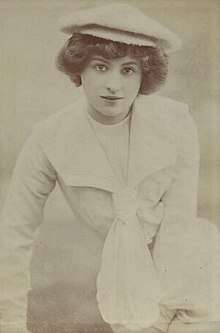Rita Martin
Margareta "Rita" Weir Martin (1875–1958) was an English photographer, considered "one of the best British photographers of her time". Martin took portraits of many suffragists and was a suffragist herself.
Biography

Margareta Weir Martin was born in 1875 in Ireland.[1]
In 1897 Martin became a photographer working for her elder sister Lallie Charles, a society photographer. Charles' studio was called "The Nook", 1 Titchfield Road, Regent's Park, London.[2] In 1906 she opened her own studio at 27 Baker Street.[3] She specialized in portraits in pale colours against a pure white background. Her main subjects were actresses (Winifred Barnes, Lily Elsie, Julia James and Lily Brayton) and children (Gladys Cooper's two children).[4] She influenced many other photographers, especially in child portraits, and her influence can be seen in many of the popular French and German photographs of children taken at the beginning of the 20th century.[5]
She was inspired by Alice Hughes; other pioneer women photographers of her time are: Christina Broom, Kate Pragnell and Lizzie Caswall Smith.[6] Talking about her, Cecil Beaton said: "Rita Martin, and the pale terracotta loveliness of her photographs are part and parcel of this period. Rita Martin and her sister, Lallie Charles, the rival photographer, posed their sitters in a soft conservatory-looking light, making all hair deliriously fashionable to be photo-lowered".[7]
A 1910 review by The Strand Magazine said "Rita Martin deserve to be singled out for praise. Perhaps a time will come when there will be annual exhibitions of the best achievements of professional photographers, as there is now for professional painters, and when that time comes the work of these artists will be highly valued by the critics. In the art of the camera as it concerns the taking of children I should put sympathy first— sympathy even before technical skill in posing and lighting."[8]
Martin took portraits of many suffragists, like Rosamund Massy, and was a suffragist herself.[9]
Martin was also a painter of miniatures.[10]
Legacy
Few negatives by Rita Martin and Lallie Charles are preserved at the National Portrait Gallery donated by their niece Lallie Charles Martin in 1994.[4]
References
| Wikimedia Commons has media related to Rita Martin. |
- "BEAUTIFUL STAGE ACTRESS: JULIA JAMES". THE CABINET CARD GALLERY. Retrieved 18 January 2018.
- Rideal, Liz (2002). Mirror, Mirror: Self-portraits by Women Artists. Watson-Guptill Publications. p. 46. Retrieved 18 January 2018.
- British photographers. 1944. p. 30. Retrieved 18 January 2018.
- "Rita Martin (1875-1958), Photographer". National Portrait Gallery. Retrieved 18 January 2018.
- The British Journal of Photography, Volume 123. Henry Greenwood & Company Limited. 1976. p. 1135. Retrieved 18 January 2018.
- "Women Pioneers". The Hyman Collection. Retrieved 18 January 2018.
- Beaton, Cecil (1933). The Book Of Beauty. Retrieved 18 January 2018.
- The Strand Magazine, Volume 39. 1910. p. 73. Retrieved 18 January 2018.
- Crawford, Elizabeth (2003). The Women's Suffrage Movement: A Reference Guide 1866-1928. Routledge. p. 548. Retrieved 18 January 2018.
- FAN: Feminist Arts News, Volume 2, Issues 1-10. FAN - Feminism and the arts. p. 25. Retrieved 18 January 2018.